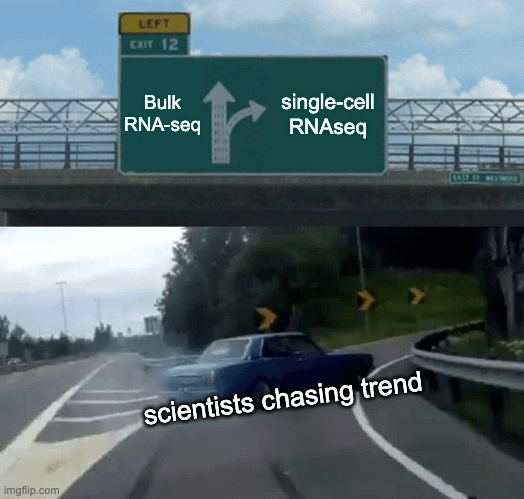|
Hello Bioinformatics lovers,
Tommy here. I was on the bioinformatics lab podcast. Check it out if you want to hear my story.
Today, we will talk about single-cell RNAseq. (btw, I made this PCA and CCA for cell annotation tutorial for you)
You don’t always need single-cell RNA-seq.
In fact, in many cases, it’s the wrong tool for the job.
We get it—single-cell RNA-seq is hot. It feels cutting-edge. But too often, researchers jump to it without asking a critical question:
Is this the best method for answering my hypothesis?
Bulk RNA-seq Isn’t Dead—It’s Just Overlooked
Despite the hype, bulk RNA-seq remains:
- Cheaper
- Simpler
- Statistically stronger with replicates
If your samples are already purified or sorted—like FACS-isolated T cells—do you really need the extra noise and complexity of single-cell?
Where Bulk RNA-seq Still Wins
✔️ Homogeneous samples (like cell lines)
✔️ High-throughput designs with many conditions
✔️ Studies where replication is key (e.g., drug treatments, time-course)
✔️ Situations where per-cell resolution won’t change your biological conclusion
But What If I Do Need Single-Cell?
Use scRNA-seq if your question depends on:
- Detecting rare populations
- Disentangling heterogeneous tissues
- Discovering cell-type-specific signals
In these cases, resolution matters—and scRNA-seq earns its price tag.
But know this: you’re trading off simplicity, QC, and replicability.
The Budget Dilemma No One Talks About
Say you’ve got the money for:
- One scRNA-seq run across 4 conditions
OR
- Triplicate bulk RNA-seq across the same 4 conditions
Which is better?
Replication wins almost every time.
It gives you confidence in what you see, not just pretty plots.
Questions to Ask Before Choosing a Method
- What’s my biological question?
- Do I need per-cell resolution to answer it?
- Will replication give me more power?
- Can I simplify without compromising insight?
Science isn’t about chasing trends—it’s about chasing truth.
TL;DR — Key Takeaways
✅ Use single-cell RNA-seq when resolution is truly needed
✅ Use bulk RNA-seq when replication, simplicity, and cost matter more
✅ Let your question—not the technology—guide your methods
Action Items
- Define your hypothesis clearly
- Match your method to your biology, not the latest buzzword
- Don’t default to scRNA-seq just because it’s “cool”
What method did you use in your last study?
Hit reply—I’d love to hear your thought process.
Other posts that you may find helpful
- untaught skill: how to name files.
- Two types of bioinformaticians walk into a lab. One scales to 10,000 genomes. the other dissects one elegant experiment.
- Last Sunday, we went sea fishing with a group of Chinese professionals from Yale. One of them suffered severe seasickness.
- You’re merging gene data across tools. Suddenly nothing matches ENSEMBL, ENTREZ, TP53, P53... Why so many gene IDs?
- The biomarker test could change a patient’s life. What is it? 🧵
- Bioinformaticians: our people skills matters as much as our code. Here’s why communication is your most underrated tool 🧵
- Think early cancer trials are where breakthroughs begin? The truth is harder. Here’s what you want to know 🧵
- Your genomics analysis is only as good as your reference. Use the wrong genome build, and you’ll misplace peaks, CpG sites, and genes. Here's why that matters 🧵
- what happens when you meet someone in person after knowing each other for over 10 years online?
- You love R for bioinformatics. You live in Unix. So why not turn your R scripts into command-line tools? Here’s why you should.
- Drug development is brutal. Not because we lack smart people—but because we lack good models. Here's why that matters, deeply.
- You're not just sequencing single cells. You're sequencing the soup they're in. Ambient RNA is everywhere in single-cell RNA-seq. Here's how to fix it.
- 100 million cells in a single-cell study sounds massive. But do you know how many cells are in one human body? Try 30 trillion.
- Can you trust a boxplot with a small sample size? Not always. The median might lie to you. Let’s simulate why, with R code.
- You will stand out ahead of 99% of the people in anything if you do the following
Happy Learning!
Tommy aka crazyhottommy
PS:
If you want to learn Bioinformatics, there other ways that I can help:
- My free YouTube Chatomics channel, make sure you subscribe to it.
- I have many resources collected on my github here.
- I have been writing blog posts for over 10 years https://divingintogeneticsandgenomics.com/
Stay awesome!
| 